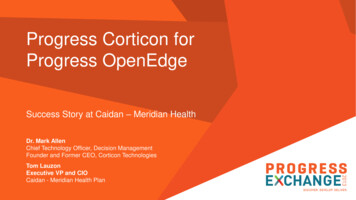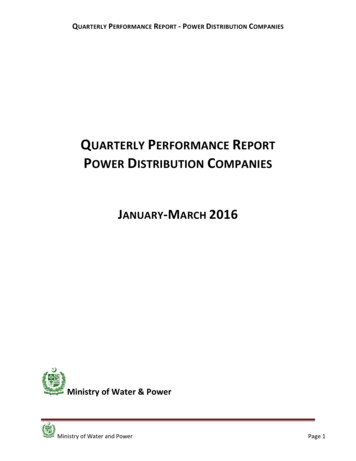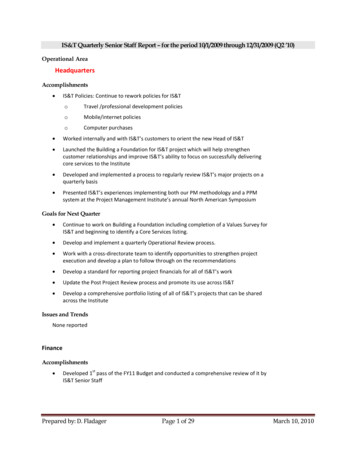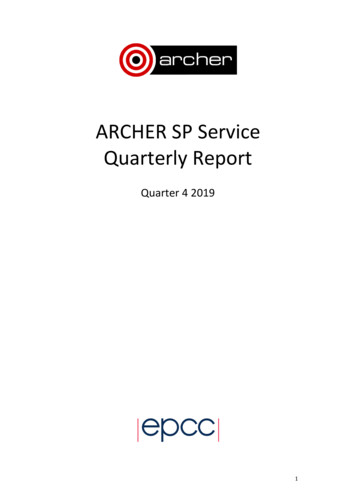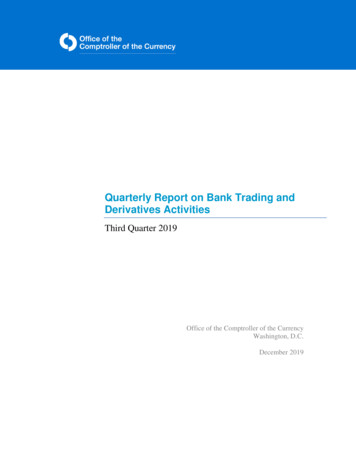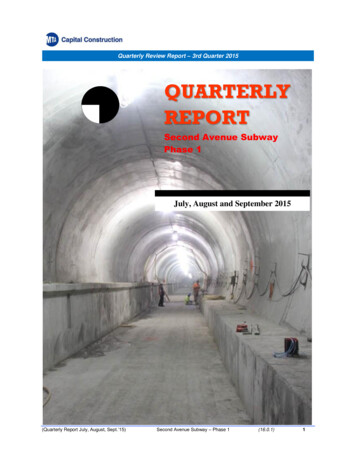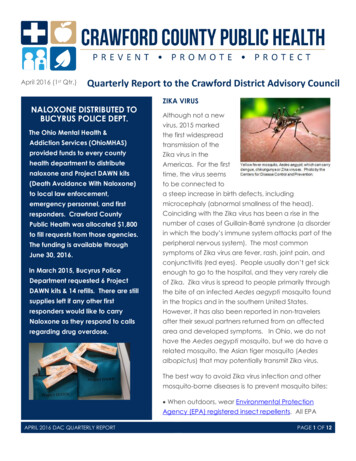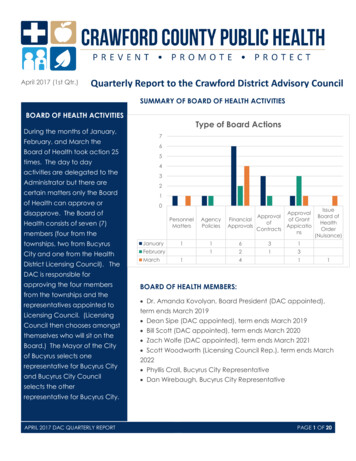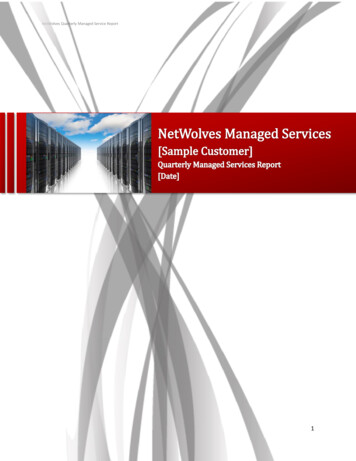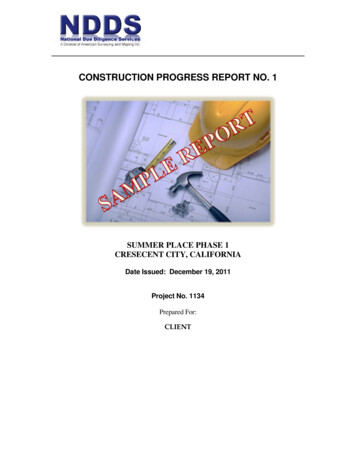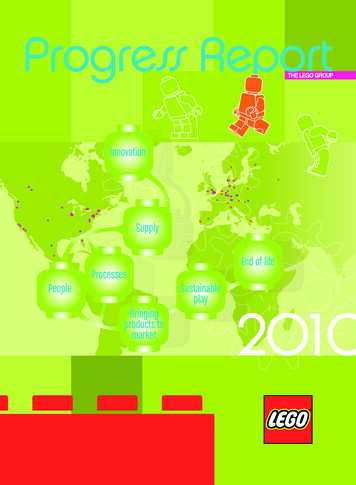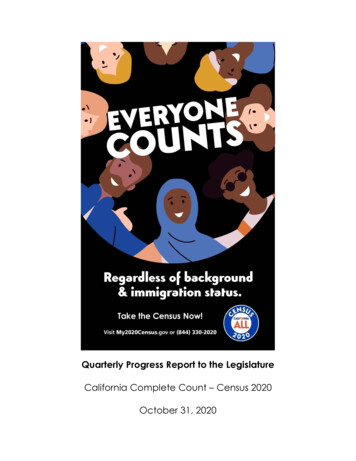
Transcription
Quarterly Progress Report to the LegislatureCalifornia Complete Count – Census 2020October 31, 2020
[This page facilitates double-sided printing]
TABLE OF CONTENTSI.EXECUTIVE SUMMARY1II.BUDGET AND INFRASTRUCTURE6OverviewFunding AllocationsFunding Overview Charts and TableContracted Outreach PartnersStatewide Nonresponse FollowupCounty and Tribal GovernmentsRegional Administrative Community-Based Organizationsand Statewide ContractsEducation SectorSector (Non-Education)Homebase & Enumeration of People ExperiencingHomelessnessState Agency OutreachCensus Office Nonresponse Followup Engagement TeamOutreach and Public Relations 0Staffing and OrganizationContingencies and EmergenciesCalifornia Complete Count Committee303133NEXT STEPS33
EXHIBITSPlease note that some exhibits may contain their own page numbers,attachments, or exhibits.A.Contractor Deliverables and Payment ApprovalsB.CA Complete Count - Census 2020 Office Funding Allocations by RegionC.CA Census Office Campaign SnapshotD.July-August 2020: Week of Action RecapE.September 2020: Week of Action RecapF.Peer Learning LabsG.Organizational Chart
I. Executive SummaryThis report serves as the ninth quarterly update that the California Census Office (CensusOffice) has submitted to the Legislature, as required in Section 45 of Senate Budget Bill866, Chapter 53, Statutes of 2018 (SB 866). Per these requirements this report is beingpresented to the Joint Legislative Budget Committee, the Senate Select Committee on2020 U.S. Census, and the Assembly Select Committee on the Census.Additionally, as required by SB 866, the report consists of 1) the overall budget, includingthe annual allocations for community-based organizations, and media outreach; and2) the total amount of funds allocated to organizations.The budget allocations and funding tables reflect encumbrances and expendituresthrough September 30, 20201. Exhibits and other program dates are as specified.As reported in the Quarterly Report of July 2020, the COVID-19 pandemic had anincredible impact on the enumeration operations conducted by the U.S. Census Bureauand the outreach work coordinated by the Census Office. In addition to this, there wereseveral other external impacts on the campaign that were unexpected. The following isa partial list of impacts that further restricted the Census Office and contracted partners’ability to conduct outreach and for the U.S. Census Bureau to walk neighborhoods andknock on doors to enumerate households: Numerous complex wildfires across the state, including the August Complex firewhich has evolved into a rare ”gigafire” (burning at least a million acres of land)and largest fire in California’s history; Intense heatwaves that broke temperature records that caused power outagesin several areas across the entire State of California; Civic unrest regarding racial equity and justice, including those led by the BlackLives Matter movement; and The November 3, 2020 national election, coupled with the extension of the Censuscampaign, created an environment of competing campaigns, informationfatigue and increased media costs.Compounding these challenges, the U.S. Census Bureau’s major timeline changes andresulting litigation created uncertainty over a short period of time. These changescompelled the Census Office to repeatedly truncate or stretch resources over a veryshort time period: 1On August 3, 2020, the U.S. Census Bureau suddenly changed course andshortened the data collection timeline by one month from October 31, 2020 toAccording to state accounting practices.Page 1 of 35
September 30, 2020. This change compelled the Census Office to truncateoutreach and media activities; On September 24, 2020, U.S. District Judge Lucy Koh in the Northern District ofCalifornia granted a preliminary injunction that required the U.S. Census Bureau tocontinue data collection efforts through October 31, 2020. This change compelledthe Census Office to assess resources and extend activities where possible; On September 28, 2020, U.S. Department of Commerce Secretary Wilbur Rossannounced the U.S. Census Bureau’s intention to conclude the 2020 Census onOctober 5, 2020; On October 7, 2020, the United States Court of Appeals for the Ninth Circuit upheldJudge Koh’s order to continue data collection through October 31, 2020; and On October 13, 2020, the U.S. Supreme Court set aside the United States Court ofAppeals Ninth Circuit order to continue data collection through October 31, 2020,effectively ending the Census. The same day, the U.S. Census Bureau announcedit was ending the Census on October 15.The third quarter of 2020 was the most complex of the campaign yet; however, theCensus Office remained resolute in continuing to ensure all Californians are counted. TheCensus Office worked diligently to deploy funding and resources to support activities inthe Nonresponse Followup (NRFU) period in several focused areas: Executed the NRFU strategy in areas of 21 counties that had the most significantself-response challenges and deployed 8 million in additional funding to supporton-the-ground outreach; Solicited and on-boarded a new contractor to conduct a phone bankingprogram in areas of low self-response to patch-through calls to the U.S. CensusBureau; Expanded the patch-through phone banking program to include a text-bankingprogram; Launched two statewide “Week of Action” (WOA) initiatives to coordinatepartners and create key inflection points to drive earned media for the campaign; Deployed additional paid media in multiple languages and in low self-responserate areas that complemented the community-based organizations’ on-theground activities; Developed several rounds of updated messaging guidance to express urgencyand support partners during the many changes in the U.S. Census Bureau timeline;and Supported state-funded partners, such as philanthropy, and other philanthropicorganizations, Census Policy Advocacy Network members, and local governmentPage 2 of 35
statewide associations, through the month of October to continue to deploytrusted Census messages into hard-to-count communities.The following table reflects the 1) self-response rates, 2) final 2010 self-response rate and3) percentage point difference for each of California’s 58 counties as of October 17,2020.It is important to note that the self-response rate does not include other counts suchNRFU and Group Quarters, but rather only those who self-responded via online, phone,or mail. The addition of these other counts will likely increase a county’s response. TheU.S. Census Bureau is still processing data from all of the different enumeration methods,and final rates are not expected until 2021.The county self-response rates are sorted in alphabetical order.CountyAlameda CountyAlpine CountyAmador CountyButte CountyCalaveras CountyColusa CountyContra Costa CountyDel Norte CountyEl Dorado CountyFresno CountyGlenn CountyHumboldt CountyImperial CountyInyo CountyKern CountyKings CountyLake CountyLassen CountyLos Angeles CountyMadera CountyMarin CountyMariposa CountyMendocino CountyMerced CountyCumulative SelfResponse Rate(SRR) as of Oct. inal 2010 . pointdifference 20202010 (positivenumbers reflect ahigher SRR,negative numbersreflect a lower 0.936.50.8-3.9-5.34.2-6.82.43Page 3 of 35
CountyModoc CountyMono CountyMonterey CountyNapa CountyNevada CountyOrange CountyPlacer CountyPlumas CountyRiverside CountySacramento CountySan Benito CountySan Bernardino CountySan Diego CountySan Francisco CountySan Joaquin CountySan Luis Obispo CountySan Mateo CountySanta Barbara CountySanta Clara CountySanta Cruz CountyShasta CountySierra CountySiskiyou CountySolano CountySonoma CountyStanislaus CountySutter CountyTehama CountyTrinity CountyTulare CountyTuolumne CountyVentura CountyYolo CountyYuba CountyCumulative SelfResponse Rate(SRR) as of Oct. 170.471.171.764.230.565.455.776.774.263.7Final 2010 769.161.447.46548.272.571.562Pct. pointdifference 20202010 (positivenumbers reflect ahigher SRR,negative numbersreflect a lower 7.54.22.71.7Page 4 of 35
Background and detail on the programs, operations and administrative actions referredto in this document can be found in the previous quarterly progress reports to theLegislature, available at census.ca.gov/reports.Additional updates will be made available on the California Complete Count – Census2020’s (Census Office) website at census.ca.gov on an ongoing basis.Page 5 of 35
II. BUDGET AND INFRASTRUCTUREOverviewThe Census Office’s budget structure remains unchanged since the last appropriation inthe Fiscal Year (FY) 2019-20 Budget Act. The 187.231 million multi-year allocation isoutlined in the table and charts below. The available balance is current throughSeptember 30, 2020 and includes state programmatic costs for the administration of theCensus Office through June 30, cumbered2017 Budget Act 1 & 2 10,000,000 9,312,459 2018 Budget Act 90,300,000 77,641,215 2019 Budget Act 86,931,000 72,633,560Total: 187,231,000 159,587,234- 687,5417,637,467 5,021,319 13,312,960 984,480 20,950,427 6,693,3391. The 10 million includes two separate budget actions that provided 7 million for the LUCA incentive program and 3million for initial planning activities that were conducted within the Governor's Office of Planning and Research. 295,000of the expended amount covered administrative costs at the Department of Finance.2. The initial 3 million budget allocation appropriated under the Governor's Office of Planning and Research has aremaining balance of 687,541. This amount is not available and has reverted on June 30, 2020.Funding AllocationsThe pie chart below reflects current funding allocations for Census Office programs.Page 6 of 35
The pie chart below reflects outreach funding allocations.Page 7 of 35
The table below reflects program allocations:California Complete Count OfficeCensus 2020 Program Funding OverviewOriginalFundingAllocationsProgrammatic Area2019 BudgetAct FundingAllocationsTotal AllocationLocal Update of Census Address (LUCA)Incentive Payments 7,000,000LUCA Appeals - (1,295,000) 5,705,000 217,500217,500OutreachCountiesCounty Agreements 26,683,500 (684,269) 25,999,231Additional Allocation for County - 6,094,826 6,094,826NRFU Allocation - 1,161,315 1,161,3151/Tribal OutreachTribal Government Agreements 316,500Statewide Tribal Agreements - 1,647,855- 1,647,855 316,500Media and Additional Tribal Agreements and CBO Contracts - 943,637 Regional Contracts 22,950,000 684,269 23,634,269Additional Allocation for ACBOs - 8,042,256 8,042,256NRFU Allocation - 8,188,686 8,188,686943,637Regional Administrative Community-Based Organizations (ACBO)Statewide Community-Based Organization Contracts 4,050,000 977,000 5,027,000Additional Allocation for Statewide 2,631,100 2,631,100State Programmatic CostsNRFU Allocation- 6,000,000 371,849 --Phone Banking Program 6,371,849 - 3,158,079 3,158,079EducationCounty Office of Education Contracts 750,000 4,673,469 5,423,469Census Education K-12 Curriculum 250,000 Higher Education 50,000State Programmatic Cost Faith Based, Labor, Healthcare, Rural & Other Target SectorsAdditional Allocation for SectorState Programmatic Cost172,062422,062 1,431,795 1,481,795200,000 190,027 800,00 500,000 1,300,000 - 617,650 617,650 200,000 125,846 325,846 500,000 (200,000) 300,000 - 187,000390,027Sector (Non-Education)State Agency OutreachState Agency Programmatic Cost187,000Outreach and Public Relations CampaignStatewide Contract 16,100,000 30,000,000 46,100,000 - 3,053,813 3,053,813 1,400,000 1,729,724 3,129,724Contingencies/Emergencies 1,000,000 (742,243) 257,757California Complete Count Committee - - - 5,430,000 5,430,000 12,050,000 7,622,755 19,672,754 100,300,000 86,931,001 187,231,000NRFU AllocationState Programmatic CostCalifornia Housing and Sample Population Enumeration2/AdministrationTotals 684,269 was redirected to County Alternate Fiscal Agents2/ 295,000 is Department of Finance Administrative Costs-1/Page 8 of 35
See Exhibit A for a list of received Contractor Deliverables and Payments and Exhibit B forFunding Allocations by Region.Contracted Outreach PartnersStatewide Nonresponse FollowupShortly after publishing the second quarter legislative report of 2020, the U.S. CensusBureau NRFU phase began on August 12. During this operation, federal employees,known as enumerators, were deployed into the field to knock on doors and counthouseholds who did not self-respond by phone, online or mail.In the NRFU plans, submitted from June through July 3, contracted partners outlined theiroutreach activities for two scenarios, shelter in place and non-shelter in place. Theactivities were targeted to low response census tracts that were identified by using thelatest self-response data. As NRFU continued, this approach allowed contracted partnersto adjust their efforts by shifting to high need, low-responding census tracts.During this time period, many outreach partners had to help support the communitymembers to deal with the increases of COVID-19 cases, impacts due to wildfireevacuations, heatwaves and power shutoffs, all while still conducting Census Outreach.Community-based organizations provided services and resources to communitymembers who faced disproportionate social equity concerns, health and wellnessconcerns, food insecurity, and job losses. These communities are also the same onesoften referred to as “Historically Undercounted” and who live in hard-to-count censustracts. Moreover, as the U.S. Census Bureau operation timelines bled into election season,some organizational staffing and resources that were previously dedicated to Censushad to shift to a focus on local and national elections, per their organizations.Even with these additional challenges, most outreach partners were able to implementtheir NRFU Plan activities. The contracted partners stated they would conduct a varietyof activities and adjust these to an in-person or a virtual environment, depending onwhich was most appropriate. As California’s shelter in place order relaxed and areas ofthe state started to open up, partners conducted outreach at locations where peoplegather, according to local health directives.A summary of partner NRFU Plan activities include: Materials: Creation and distribution of materials including banners, postcards,toolkits, bags, facemasks, lawn signs, table tents, coasters, bookmarks andstickers.Flyers/Mailers: Flyers distributed with school lunches, through food banks,diaper distributions, farmworker “crew of the week” lunches, senior mealdelivery, independent food delivery services, grocery stores, laundromats andCOVID-19 testing centers, and mailers to P.O. Boxes, in utility bills,unemployment packages, through “every door direct mail” and letter writingcampaigns.Page 9 of 35
Text/Email/Phone Banking: Weave Census messaging into telehealth visitreminders, outbound call campaigns, including “patch through” callprograms, calls via schools “robo-calling” systems, on hold messages and textmessaging.Outreach and Events:o Virtual activities: Events, town halls, Questionnaire Assistance Centers(QACs), library story time, webinars, presentations, forums, convenings,civic meetings and influencer campaigns, raffles and viral videochallenges;o Social distancing in-person activities: Caravans, community walks in lowresponse rate neighborhoods, faith-based, street team artist activities,and no contact canvassing; ando In-person safe activities: Outreach in waiting rooms, onsite foodgiveaways, art events, taco trucks, grocery stores, and supporting U.S.Census Bureau mobile questionnaire assistance centers.Media: Amplify partner messaging in multiple languages on social media andearned media, radio, TV, ads on transit buses, print, newspaper articles, videosin waiting rooms, video creation, social media and viral video challenges,billboards, public signage, e-trailer signs, press releases, press events and PublicService Announcements (PSAs).Below is a snapshot of activities reported to the Census Office by partners for July, Augustand September 2020:Activity TypePhone BankingCanvassingNudge/AlertOtherSocial MediaAdvertisingEventsFlyersNumber of 60557,229168,654The Census Office supported on-the-ground efforts with a supply of personal protectiveequipment (PPE). In early August, the Government Operations Agency facilitatedsupport from the Governor’s Office of Emergency Services to secure a one-time order ofPPE for contracted partners and other entities. The following equipment was provided:KN-95 MasksProcedural MasksFace ShieldsTotal Quantity37,95742,40017,755Total Entities444244Page 10 of 35
Hand SanitizerLatex Gloves34,79678,9984642Shifting October Partner LandscapeAs mentioned in the Executive Summary, the timeline of the Census shifted several times.When the United States Court of Appeals for the Ninth Circuit upheld Judge Koh’s orderto require the U.S Census Bureau to continue data collection through October 31, 2020the Census Office surveyed partners on September 25, 2020 asking if they would be ableto extend activities from the end of their contract date of September 30, 2020 throughthe month of October. Some of the partners and their subcontractors or grantees did nothave the staff capacity or budget to continue their activities. Some partners stated thatthey shifted their responsibilities to pandemic relief, fire emergencies, or in some casesget out the count activities.Below is a high-level summary of partners that indicated they had capacity to continueconducting Census outreach activities. Some of the activities included social media,virtual and community events, text banking, phone banking, and canvassing.Partner NameACBOUnited Way of Bay AreaVentura Co Community FoundationCalifornia Community FoundationCharitable VenturesFaith in ActionSacramento Region Community FoundationUnited Way of San DiegoSECTOR4HPICOSTATEWIDECHIRLA (I&R)California Indian Manpower ConsortiumDisability Rights Education and Defense Fund (DREDF)Equality CAHomebaseLatino Community FoundationMixteco Indigena Community Organizing Project (MICOP)Asian American Advancing JusticeCalifornia Rural Legal AssistanceHIGHER EDUCATIONCSU Chancellor's OfficeTRIBAL GOVERNMENTSActivity thru Oct LimitedYesYesYesYesYesYesYesLimitedLimitedYesPage 11 of 35
Karuk TribeSherwood Valley RancheriaSusanville Indian RancheriaWashoe TribeTolowa Dee-ni' NationViejas Band of Kumeyaay IndiansCOUNTYAlameda CountyCalaveras CountyCity of StocktonImperial CountyLos Angeles CountyMarin CountyMerced CountyModoc CountyMonterey CountyNapa CountyRiverside CountySanta Clara CountySutter CountyTulare CountyTuolumne CountyColusa CountyContra Costa CountyInyo CountyKern CountyKings CountyMadera CountySacramentoSan Benito CountySan BernardinoSanta Barbara CountySanta Cruz CountyStanislaus CountyCOEAlameda CountyLake CountySacramento CountySan Bernardino CountyLos Angeles CountyTuolumne itedLimitedYesYesYesLimitedLimitedLimitedPage 12 o
NRFU and Group Quarters, bu t rather only those who self-responded via online, phone, or mail. The addition of these other counts will likely increase a county’s response. The U.S. Census Bureau is still processing data from all of the different enumerat
